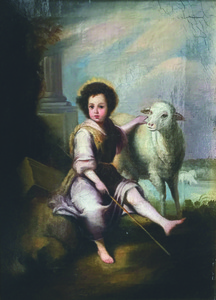

Edward Chalmers Leavitt, Christ as the Good Shepherd, (after the Spanish Baroque painter Bartolemé Esteban Murillo, 1660), oil, 21†x 17†is one of the artworks on display at William King Museum of Art, Abingdon, Virginia.
William King Museum of Art, Abingdon, Virginia, celebrates Easter and the beginning of springtime with its “Touching the Sacred†exhibit. The exhibit is on display until Sept. 16. A reception is held April 5 from 6-8 p.m.
Mary Haviland, curator, chose works of art that are considered to be icons: paintings and sculpture that are thought to have a sacred power in worship, such as healing or protection.
The exhibit contains works from all over the Christian world: Russian icons on wood panels, Ethiopian objects from North Africa, paintings of the Madonna and Christ child from Europe and retablos from central Mexico. A retablo is a small oil painting on tin, wood and sometimes copper which are used in home altars.
“Religious art gives us a grounding for the mystery of the sacred. Religious iconography, the symbolism of an object, immediately tells the viewer the meaning of the sacred text, whether in Bible stories or the liturgy of the service. For example, the cross is an icon recognized around the world as the crucifixion of Christ and, from that, we expand the story in our minds. In art history, religious art connotes the culture surrounding the work, allowing comparison with other historical traditions.
“We are showing the work of some highly respected artists. For instance, the 20th century English sculptor Jacob Epstein’s ‘Christ in Majesty’ is outstanding. The Mexican ex-votos, small devotional paintings that depict a miracle performed by the Virgin or a particular saint, are particularly endearing as a type of folk art unique to the individual artist. They are sometimes called ‘please and thank-you’ paintings, appealing for rescue from trouble or showing gratitude for healing. Other works are more typical icons, painted in the centuries old tradition of Byzantine iconography that was disseminated by the Greek Orthodox Church,†Haviland says.
Haviland, who has a doctorate in art history, presents a lecture on “Touching the Sacred†in the William King Museum of Art’s library, April 15 at 3 p.m. The lecture is $5 and is open to the public.
THERE'S MORE
>> Rhonda leads tours more